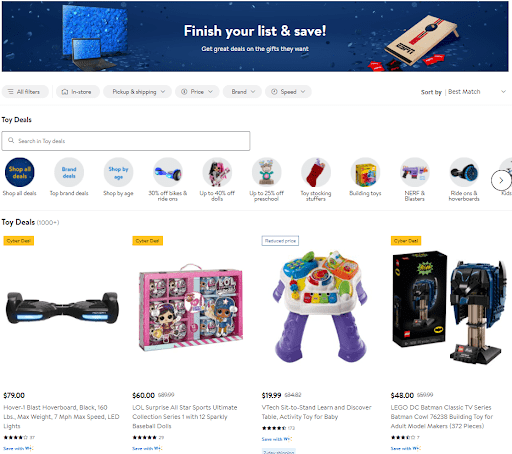Ecommerce is an ever-growing industry. It is estimated that there are between 12 and 24 million eCommerce stores in the world. As we can see, the competition is fierce.
It is not enough to simply create your eCommerce website and expect your business to grow on its own. You need to use any means necessary to boost the visibility of your eCommerce store.
To help your business succeed, we are giving you five tips on how to boost the visibility of your eCommerce store:
- Upgrade Search Engine Optimisation (SEO)
- Use marketing automation
- Perform analysis on your competition
- Focus on user experience
- Be active on social media
1. Upgrade SEO
SEO helps your eCommerce store be more visible in the search engine result pages (SERPs). You want your eCommerce store to rank high in SERPs and here is how to do it.
Choose the right keywords
Keywords are very important for developing an eCommerce SEO strategy.
Google Ads provides a Keyword Planner that can locate keywords from search inquiries and sort them by search volume, monthly search, and competition. There are other tools you can use such as SEMrush, UberSuggest by Neil Patel, Moz, etc…
Use one of these tools to help you identify words and phrases that are relevant to your line of business and implement them in your digital marketing.
Use your primary keyword in product headline, subheadlines, image alternate attributes, description, and meta description.
In this context, Yates Jarvis (LinkedIn), a marketing consultant for e-commerce store, offers the following advice:”Harnessing the power of the right keywords transcends basic SEO practice—it’s about weaving the essence of your brand into the digital fabric where visibility meets relevancy. By integrating these targeted phrases not just across your product listings but within the core narrative of your e-commerce platform, you’re not simply optimizing; you’re crafting a magnet for both search engines and the hearts of your customers.
Implement SEO on your homepage
Most businesses prioritize SEO strategies on their homepages, and for good reasons too.
Your homepage is the first thing users encounter when they visit your website and it is a great place to implement your keywords in your title, meta description, and content. This will give Google a clear indication of what your business is about.
The image below is Adidas’ homepage. As you can see, it has all the necessary keywords implemented on its first page such as clothes, shoes, jacket, pants, etc. and it is very easy to navigate. It fulfills both SEO and user experience requirements.

Simplify your website construction
SEO will base its ranking on a distinct internal linking structure of your website pages and products.
Your website needs to have clear navigation from your homepage to product categories and individual products listed within those categories. Ideally, your visitors should get from the homepage to where they can purchase any product in just three clicks.
Walmart’s website is a great example of reaching your desire in three clicks. The first image is their homepage and if you click on the “Toy gift” icon, it will lead you to the selection of toys, click on the desired toy, and with one more click, your item will be added to the cart.




Improve product pages
Product pages are the soul of your eCommerce business. Improving product pages by adding more information on your product helps Google find your website.
Here are two tactics to use when improving product pages for SEO:
- Product name optimization – you need to attach a frequent search term or a keyword phrase to your product name. This is important since your product name is used in the SEO title and URL of your product page.
For instance, if you sell makeup, include “makeup” in the product name, or use a long-tail keyword such as “makeup-for-all-skin-types”, so that the keyword ends up in both SEO title and URL. - Image optimization – Images on your website should illustrate your products clearly and from more than one angle.
Start by specific naming of image files. Don’t name your images IMG002.jpg, instead use words that describe the image, for example, black-army-T-shirt.jpg. Precise naming of your images will help your product appear in Google Image Search.
Use the mobile-friendly design for your website
Google ranks responsive website designs by its mobile-first index.
Make your website fit any screen. With technological evolution, more people use mobile devices to browse the internet, so making your website mobile-friendly is an important step for your SEO strategy and improving the user experience.
Make your page load faster
It is very simple – the less time your page needs to load, the higher it will rank in SERPs.
To reduce the page load time, make your website as clean as possible, insert smaller images, and remove unnecessary plugins and add-ons.
As SEO strategy is very important for your eCommerce store, consider hiring an online digital agency to help you get on SERPs faster and better. Even though this requires investing some money, it can bring very measurable results.
Henry Ford explained it best: “Those who stop marketing to save money are like those who stop a clock to save time.”
2. Use marketing automatization`
Marketing automatization refers to software that automates some marketing activities, such as email marketing and social media.
Most marketing automatization software operates by automating tasks based on triggers and actions that you choose to set off.
Email marketing automatization is a method of creating emails that find the right people with the right message at the right time. It includes welcome emails, onboarding emails, transactional emails, re-engagement emails, event announcements, feedback emails, etc.
Social media marketing automatization is a method of optimizing social interactions using automation tools. It includes implementing chatbots to reply to your user messages, scheduling Facebook posts in advance, sending tweets when your audience is most active, etc.
3. Perform analysis on your competition
Studying your competition helps you follow new trends and predict the changes in the market.
The first step in conducting your analysis is identifying your main competitors. Insert your keywords in Google and on the first result page you will find your primary competitors, those that sell the same product or service as you.
Once you’ve identified your main competitors, visit their website to further examine their products or services. When examining their website try to answer the following questions:
- How detailed are their product descriptions?
- Do they lack any product compared to your eCommerce store?
- Are there any product features that you are lacking in yours?
- How do their prices compare with yours?
- What is the loading speed of their website?
Conducting this analysis will help your business become more competitive by determining your place in the eCommerce market.
4. Focus on user experience
Good user experience relies on helping the visitors navigate your website and completing their goals in the most efficient way possible.
One of the ways to improve user experience is to guide them with personalized recommendations. It is equivalent to having a shop assistant give product suggestions. Display similar products to those your visitor is searching for.
Include “the best seller” section. These are very valuable as they provide social proof for your products. As we can see in the image below, every book is graded by stars. The higher it ranks, the easier it is going to be to sell it.

Get customer feedback. As there is always room for improvement, customer feedback is very helpful for finding out how to improve your user experience and make relevant changes.
As Bill Gates put it: “Your most unhappy customers are your greatest source of learning.”
5. Be active on social media
A social media marketing strategy for your eCommerce store includes selling products directly on social media platforms, communicating with your customers and potential customers, and collecting information on your audience, competitors, and benchmarks.
You can choose to use organic or paid social media strategies or a combination of the two strategies.
Organic social media strategies include product reviews on your social media account, adding hashtags, interaction with your customers, the usage of user-generated content that benefits social proof, etc.
Paid social media strategies include paid advertisements and post boosts, influencer marketing campaigns, and brand ambassador programs, etc.
Conclusion
Ecommerce sales held 18% of the total global retail in the year 2020. and they are expected to reach 21,8% by 2024. As we can see eCommerce is constantly growing and the competition is getting tougher and tougher.
To make your eCommerce business competitive and profitable, you must get on board with the latest marketing trends and strategies.
We hope that our tips help you reach your goals and give you insight into what you need to do to boost the visibility of your eCommerce store.
Need a theme for your eCommerce site? Check out the WordPress marketplace theme by Wbcom Designs.
Author bio:
Tomas is a digital marketing specialist and a freelance blogger. His work is focusing on new web tech trends and digital voice distribution across different channels.
Don’t forget to share this article


